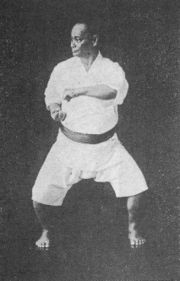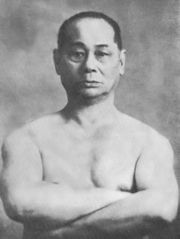Motobu Chocki
- Born 1870 Died 1944
The Okinawan karate practitioner Motobu Choki (Motobu Choki, 1870 - 1944) was born in Akahira village of Shuri, Okinawa. His father, Lord Motobu Choshin (Motobu Aji Chosin) was a descendent of the sixth son of the Okinawan King, Sho Shitsu (1629 - 1668), namely Sho Koshin, also known as Prince Motobu Chohei (1655 - 1687). As the last of three sons, Motobu Choki was not entitled to an education in his family's style of Te (an earlier name for karate). Despite this Motobu was very interested in the art, spending much of his youth training on his own, hitting the makiwara, and lifting heavy stones to increase his strength. He is reported to have been very agile, which gained him the nickname "Motobu no Saru", Motobu the Monkey.
Although he was reputed by his detractors to have been a violent and crude street fighter, with no formal training, Motobu was a student of several of Okinawa's most prominent karate practitioners. Anko Itosu (1831 - 1915), Sokon Matsumura(1809 - 1899),Sakuma Pechin, Kosaku Matsumora (1829 - 1898), and Tokumine Pechin (1860 - 1910) all taught Motobu at one time or another. Many teachers found his habit of testing his fighting prowess via street fights in the tsuji (red light district) undesirable, but his noble birth (as a descendant of the royal Okinawan Sho family) may have made it hard for them to refuse. Popular myth holds that Motobu only knew one kata, Naifanchi (Naihanchi). Although he favored this kata, and called it "the fundamental of karate," he also made comments on the practice of Passai, Chinto, and Rohai. Other sources describe Sanchin, Kusanku, and Ueseishi as having been part of his repertoire. He apparently developed his own kata, Shiro Kuma (White Bear), which seems not to have been handed down. Motobu lived and taught karate in Japan until 1941, when he returned to Okinawa, dying shortly thereafter. Prior to this, he had made several trips there to study orthodox kata and kobudo in an effort to preserve the traditional forms of the art.
After a number of failed business enterprises, Motobu moved to Osaka, Japan, in 1921. A friend convinced Motobu to enter a "boxing vs judo" match which was taking place. These matches were popular at the time, and often pitted a visiting foreign boxer against a jujutsu or judo man. According to an account of the fight from a 1925 King magazine article, Motobu is said to have entered into a challenge match with a foreign boxer, described as a Russian boxer or strongman. After a few rounds, Motobu moved in on the taller, larger boxer and knocked him out with a single hand strike to the head. Motobu was then 52 years old. The King article detailed Motobu's surprising victory, although the illustrations clearly show Gichin Funakoshi as the Okinawan fighter in question. This publication error increased the bitter rivalry between the two men, and led to an apparent confrontation. The two were often at odds in their opinions about how karate ought to be taught and used. The popularity generated by this unexpected victory propelled both Motobu and karate to a degree of fame that neither had previously known in Japan. Motobu was petitioned by several prominent individuals, including boxing champ "Piston" Horiguchi, to begin teaching. He opened a dojo, the Daidokan, where he taught until the onset of World War II in 1941. Motobu faced considerable difficulties in his teaching. Chief among those was his inability to read and speak mainland Japanese. Okinawan dialects are nearly incomprehensible to mainlanders. As a result, much of his instruction was through translators, which led to the rumor that he was illiterate.
Motobu Choki's third son, Chosei Motobu(1925 - ), still teaches the style that his father passed on to him. As a point of reference, it is important to distinguish between the "Motobu Ryu" which Chosei teaches, and "Motobu Udun Di", the unique style of the Motobu family, which bears a resemblance to aikijutsu.Now Chosei Motobu is the second Soke of Motobu Ryu and the 14th Soke of Motobu Udun Di. Motobu's karate is marked by a series of two man kumite drills, which were an advancement in the popular thinking and instructional methods of the time. His curriculum heavily favored the Naihanchi kata because of the correspondence between its applications (bunkai) and actual fighting, which he experienced in brawls as a young man.









